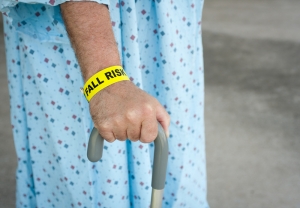Usefulness of the Berg Balance Scale to Predict Falls in the Elderly
This article was reviewed by Joseph G , PT.
Falls among the older adults are a major health concern and are the leading cause of injury deaths, nonfatal injuries, and hospitalizations for trauma among the older adults.
Falls often result in people getting referred to physical therapy following an injury or trauma. Defining falls and balance, predicting who is at risk for falls, and improving balance in the older adults are some of the leading topics in geriatric physical therapy today. Poor balance is often a result of neurological diseases, orthopedic deficits, vestibular disorders and also as a result of polypharmacy. With ongoing changes in healthcare, there is increasing pressure to more efficiently and effectively evaluate patients relative to fall risk so therapists often utilize standardized instruments to assess balance and predict falls in the older adults. Perhaps the most commonly used clinical tool to assess balance in the elderly population is the Berg Balance Scale (BBS). The BBS, created in 1989, assesses balance and risk for falls through direct observation of the participant’s performance by trained health care professionals in a variety of settings. The BBS tasks progress in challenges: from sitting to standing, standing with narrow base of support, and finally to tandem and single-leg stance. Scoring is on a 5-point ordinal scale with 0 indicating an inability to complete the task and 4 as independent with completing the task. The maximum score of 56 indicates good balance.
The scale takes approximately 10 to 20 minutes to complete requiring minimal equipment (chair, stopwatch, ruler, and step) and minimal space.
The attached research article’s purpose was to complete a comprehensive search and review of literature to determine the ability of the Berg Balance Scale (BBS) to predict falls in the elderly with and without pathology. In initial development of the BBS, the authors noted that a limitation to the scale was the lack of items requiring postural response to external stimuli or uneven support surfaces. This indicates that the BBS may be more appropriate for use with frail older adults rather than community-dwellers.
This study concluded that the BBS alone is not able to definitively predict fall risk and no cutoff score was identified in this review as the optimal score for fall risk prediction. The BBS is only one test that a clinician can use to help identify and measure changes to elderly clients’ fall risk as a part of a total balance evaluation. In conclusion, the BBS has been strongly established as valid and reliable but, according to research, there are still several factors which may indicate that the BBS should be used in conjunction with other balance measures.
For example, there are a few tasks in the BBS to test dynamic balance, which may limit its ability to challenge older adults who live independently in the community. Also the use of the BBS as an outcome measure is compromised when participants score high on initial trials. The Berg balance test is easy to administer and requires no special equipment but the determination of patients’ risk of falling may be substantially improved by also examining their environment and how well they complete their activities of’ daily life.
Source:
https://www.ncbi.nlm.nih.gov/pubmed/21937886




